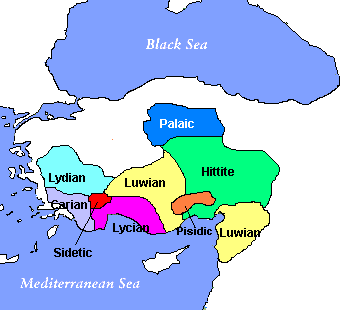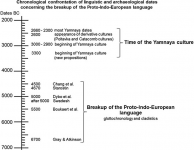Er Monnezza
Banned
- Messages
- 170
- Reaction score
- 121
- Points
- 43
PIE developed in Armenia and or Northern Iran it spread North to what is modern Georgia and CHG type people, who had adopted Farming moved North across the Caucus Mountains and traded with peoples from the Steppe, which they clearly did and they brought PIE to the Steppes.
So we don't know anything yet because we don't know what is in those new 731 samples. Again, I am not saying the Southern Arc is 100% correct but for Reich to strongly point to it suggest to me he has some genetic evidence to make such a statement.
Just at the time when an archaic form of PIE was spoken, Georgians probably already had additional Nautfian/PPNB that is missing in both Yamnaya and CHG. Darkveti-Meshoko samples are a good proxy for what Georgians were like at that time.

All the "ingredients" to make Yamnaya_RUS_Samara were already present in the Steppe/North Caucasus in 5000 BC.
PIE was spoken after 4500 BC, there is no need to bother South Caucasians to explain PIE.
Target: Yamnaya_RUS_Samara
Distance: 2.6983% / 0.02698337
60.2 RUS_Progress_En
12.4 BGR_MP_N:I1297___BC_5600___Coverage_10.31%
9.2 RUS_Progress_En
8.4 RUS_Khvalynsk_En:I0433___BC_4611___Coverage_36.95%
7.2 RUS_Khvalynsk_En:I0122___BC_4838___Coverage_48.69%
1.4 RUS_Khvalynsk_En:I0434___BC_4975___Coverage_5.32%
1.2 UKR_Meso:I5876___BC_6882___Coverage_40.60%
Target: Yamnaya_RUS_Samara
Distance: 2.9926% / 0.02992574
44.4 RUS_Progress_En
18.6 RUS_Khvalynsk_En:I0434___BC_4975___Coverage_5.32%
16.2 RUS_Khvalynsk_En:I0122___BC_4838___Coverage_48.69%
9.4 BGR_MP_N:I1297___BC_5600___Coverage_10.31%
6.8 RUS_Vonyuchka_En:VJ1001___BC_4280___Coverage_70.20%
3.0 UKR_N:I5892___BC_5119___Coverage_10.06%
1.0 RUS_Khvalynsk_En:I0433___BC_4611___Coverage_36.95%
0.6 UKR_Meso:I5876___BC_6882___Coverage_40.60%
Target: Yamnaya_RUS_Samara
Distance: 3.3413% / 0.03341335
74.4 RUS_Khvalynsk_En:I0434___BC_4975___Coverage_5.32%
11.6 BGR_MP_N:I1297___BC_5600___Coverage_10.31%
9.8 GEO_CHG:KK1___BC_7728___Coverage_99.87%
4.2 UKR_N:I5892___BC_5119___Coverage_10.06%




